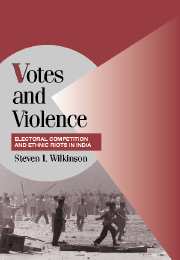Book contents
- Frontmatter
- Contents
- List of Figures
- List of Tables
- Acknowledgments
- 1 THE ELECTORAL INCENTIVES FOR ETHNIC VIOLENCE
- 2 EXPLAINING TOWN-LEVEL VARIATION IN HINDU-MUSLIM VIOLENCE
- 3 STATE CAPACITY EXPLANATIONS FOR HINDU-MUSLIM VIOLENCE
- 4 THE CONSOCIATIONAL EXPLANATION FOR HINDU-MUSLIM VIOLENCE
- 5 THE ELECTORAL INCENTIVES FOR HINDU-MUSLIM VIOLENCE
- 6 PARTY COMPETITION AND HINDU-MUSLIM VIOLENCE
- 7 THE ELECTORAL INCENTIVES FOR ETHNIC VIOLENCE IN COMPARATIVE PERSPECTIVE
- 8 DEMOCRACY AND ETHNIC VIOLENCE
- Appendix A Data Sources for Hindu-Muslim Riots
- Appendix B Data-Entering Protocol for Riot Database
- Appendix C Additional Results from Statistical Tables
- References
- Index
- Cambridge Studies in Comparative Politics
Appendix B - Data-Entering Protocol for Riot Database
Published online by Cambridge University Press: 28 July 2009
- Frontmatter
- Contents
- List of Figures
- List of Tables
- Acknowledgments
- 1 THE ELECTORAL INCENTIVES FOR ETHNIC VIOLENCE
- 2 EXPLAINING TOWN-LEVEL VARIATION IN HINDU-MUSLIM VIOLENCE
- 3 STATE CAPACITY EXPLANATIONS FOR HINDU-MUSLIM VIOLENCE
- 4 THE CONSOCIATIONAL EXPLANATION FOR HINDU-MUSLIM VIOLENCE
- 5 THE ELECTORAL INCENTIVES FOR HINDU-MUSLIM VIOLENCE
- 6 PARTY COMPETITION AND HINDU-MUSLIM VIOLENCE
- 7 THE ELECTORAL INCENTIVES FOR ETHNIC VIOLENCE IN COMPARATIVE PERSPECTIVE
- 8 DEMOCRACY AND ETHNIC VIOLENCE
- Appendix A Data Sources for Hindu-Muslim Riots
- Appendix B Data-Entering Protocol for Riot Database
- Appendix C Additional Results from Statistical Tables
- References
- Index
- Cambridge Studies in Comparative Politics
Summary
[The protocol reprinted here was originally developed by myself and Ashutosh Varshney for our 1950–95 dataset and was also used for the 1900–49 data I collected.]
Basic Entering Groundrules
The basic rule is to enter as much information as we can that a) will give us the informat on we need to fill in the boxes, and b) will allow us to check whether this information is an accurate reflection of the reported facts. So we should enter evidence of, e.g., different “final casualty” figures, the full range of “precipitating events” listed in the newspaper, together with a citation in the following form so we know exactly where the information in the notes comes from: “TOI 12/15/67.” Unnecessary duplication of the facts is not needed: accurate reflection of the full range of the facts present in the Times of India is what we're after.
Fields and Entry Protocol
Definition of Event
What is a communal riot? Following Olzak's work on race conflict in the USA (1992:233–34) we might identify an event as a communal riot if a) there is violence, and b) two or more communally identified groups confront each other/members of the other group, at some point during the violence. In other words, Hindu riots against the police would not count. Nor would PAC or police shooting of Muslims if there was no Hindu-Muslim violence before or after.
- Type
- Chapter
- Information
- Votes and ViolenceElectoral Competition and Ethnic Riots in India, pp. 255 - 262Publisher: Cambridge University PressPrint publication year: 2004

